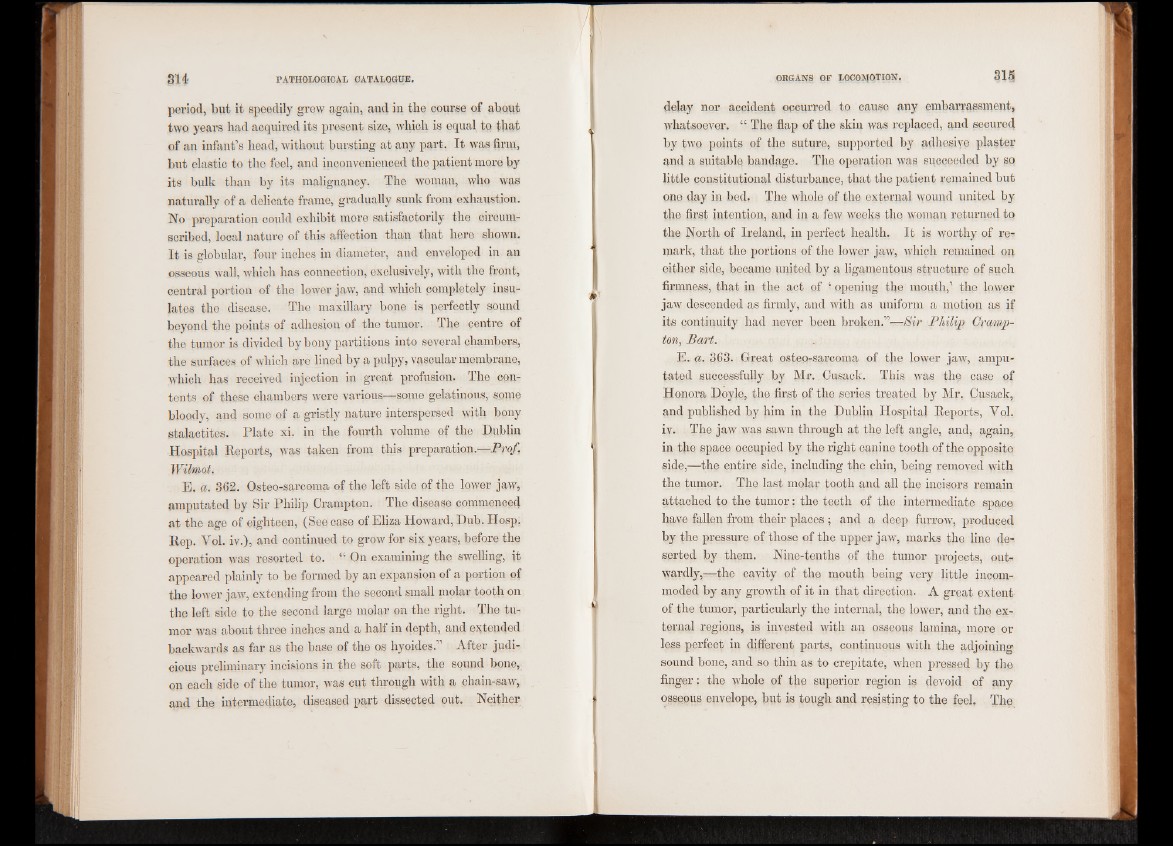
period, but it speedily grew again, and in the course of about
two years had acquired its present size, which is equal tq that
of an infant’s head, without bursting at any part. It was firm,
but elastic to the feel, and inconvenienced the patient more by
its bulk than by its malignancy. The woman, who was
naturally of a delicate frame, gradually sunk from exhaustion.
No preparation could exhibit more satisfactorily the circumscribed,
local nature of this affection than that here shown.
It is globular, four inches in diameter, and enveloped in an
osseous wall, which has connection, exclusively, with the front,
central portion of the lower jaw, and which completely insulates
the disease. The maxillary bone is perfectly sound
beyond the points of adhesion of the tumor. The centre of
the tumor is divided by bony partitions into several chambers,
the surfaces of which are lined by a pulpy, vascular membrane,
which has received injection in great profusion. The contents
of these chambers were various—some gelatinous, some
bloody, and some of a gristly nature interspersed with bony
stalactites. Plate xi. in the fourth volume of the Dublin
Hospital Reports, was taken from this preparation —Prof,
Wilmoi.
E. a. 362. Osteo-sarcoma of the left side of the lower jaw,
amputated by Sir Philip Crampton. The disease- commenced
at the age of eighteen, (See case of Eliza Howard, Dub. Hosp.
Rep. Yol. iv.), and continued to grow for six years, before the
operation was resorted to. | On examining the swelling, it
appeared plainly to be formed by an expansion of a portion of
the lower jaw, extending from the second small molar tooth on
the left side to the second large molar on the right. The tumor
was about three inches and a half in depth, and extended
backwards as far as the base of the os hyoides.” After judicious
preliminary incisions in the soft parts, the sound bone,
on each side of the tumor, was cut through with a chain-saw,
and the intermediate, diseased part dissected out. Neither
delay nor accident occurred to cause any embarrassment,
whatsoever. 44 The flap of the skin was replaced, and secured
by two points of the suture, supported by adhesive plaster
and a suitable bandage. The operation was succeeded by sq
little constitutional disturbance, that the patient remained but
one day in bed. The whole of the external wound united by
the first intention, and in a few weeks the woman returned to
the North of Ireland, in perfect health. It is worthy of remark,
that the portions of the lower jaw, which remained on
either side, became united by a ligamentous structure of such
firmness, that in the act of 4 opening the mouth,’ the lower
jaw descended as firmly, and with as uniform a motion as if
its continuity had never been broken.”—h>ir Philip Cramp-
ton, Bart.
E. a. 363. Great osteo-sarcoma of the lower jaw, amputated
successfully by Mr. Cusack. This was the case of
Honora Doyle, the first of the series treated by Mr. Cusack,
and published by him in the Dublin Hospital Reports, Yol.
iv. The jaw was sawn through at the left angle, and, again,
in the space occupied by the right canine tooth of the opposite
side,—the entire side, including the chin, being removed with
the tumor. The last molar tooth and all the incisors remain
attached to the tumor: the teeth of the intermediate space
have fallen from their places ; and a deep furrow, produced
by the pressure of those of the upper jaw, marks the line deserted
by them. Nine-tenths of the tumor projects, outwardly,—
the cavity of the mouth being very little incommoded
by any growth of it in that direction. A great extent
of the tumor, particularly the internal, the lower, and the external
regions, is invested with an osseous lamina, more or
less perfect in different parts, continuous with the adjoining
sound bone, and so thin as to crepitate, when pressed by the
finger: the whole of the superior region is devoid of any
osseous envelope, but is tough and resisting to the feel, The